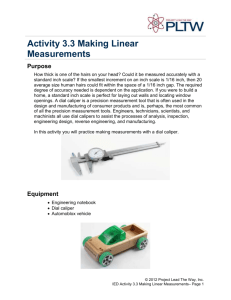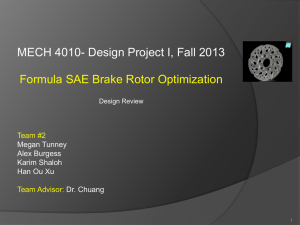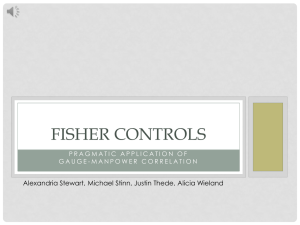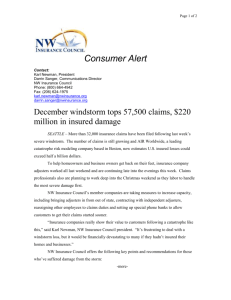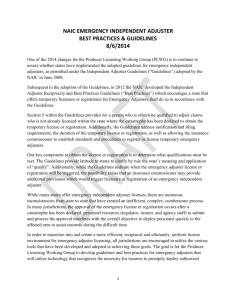Symptoms - AlfaGTV6.com
advertisement
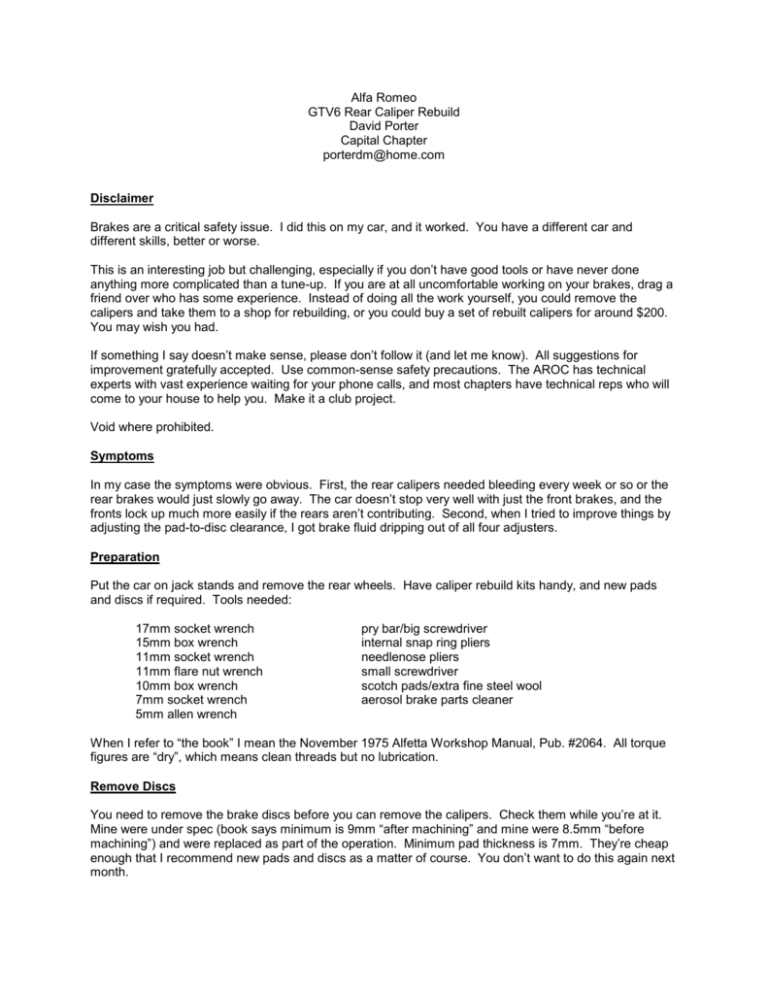
Alfa Romeo GTV6 Rear Caliper Rebuild David Porter Capital Chapter porterdm@home.com Disclaimer Brakes are a critical safety issue. I did this on my car, and it worked. You have a different car and different skills, better or worse. This is an interesting job but challenging, especially if you don’t have good tools or have never done anything more complicated than a tune-up. If you are at all uncomfortable working on your brakes, drag a friend over who has some experience. Instead of doing all the work yourself, you could remove the calipers and take them to a shop for rebuilding, or you could buy a set of rebuilt calipers for around $200. You may wish you had. If something I say doesn’t make sense, please don’t follow it (and let me know). All suggestions for improvement gratefully accepted. Use common-sense safety precautions. The AROC has technical experts with vast experience waiting for your phone calls, and most chapters have technical reps who will come to your house to help you. Make it a club project. Void where prohibited. Symptoms In my case the symptoms were obvious. First, the rear calipers needed bleeding every week or so or the rear brakes would just slowly go away. The car doesn’t stop very well with just the front brakes, and the fronts lock up much more easily if the rears aren’t contributing. Second, when I tried to improve things by adjusting the pad-to-disc clearance, I got brake fluid dripping out of all four adjusters. Preparation Put the car on jack stands and remove the rear wheels. Have caliper rebuild kits handy, and new pads and discs if required. Tools needed: 17mm socket wrench 15mm box wrench 11mm socket wrench 11mm flare nut wrench 10mm box wrench 7mm socket wrench 5mm allen wrench pry bar/big screwdriver internal snap ring pliers needlenose pliers small screwdriver scotch pads/extra fine steel wool aerosol brake parts cleaner When I refer to “the book” I mean the November 1975 Alfetta Workshop Manual, Pub. #2064. All torque figures are “dry”, which means clean threads but no lubrication. Remove Discs You need to remove the brake discs before you can remove the calipers. Check them while you’re at it. Mine were under spec (book says minimum is 9mm “after machining” and mine were 8.5mm “before machining”) and were replaced as part of the operation. Minimum pad thickness is 7mm. They’re cheap enough that I recommend new pads and discs as a matter of course. You don’t want to do this again next month. The book says to remove the pads first, but after doing one side I found that it’s easier to remove the pads after the calipers are out of the car. 1. Back Off Adjuster Screws. To get the discs off you need to increase the pad-to-disc clearance, so you need to back off the inner and outer adjusters. The outer adjusters are on the outside of the outer caliper halves and have a 17mm hex-head hard plastic dust cover, a 17mm locknut, and a 5mm allenhead socket on the end. The inner adjusters are on the back of the inner caliper halves and have a 7mm hex head and no locknut or dust cover. I have read many descriptions of which way to turn what, but here’s what I found: a. Outer: Both of the outer adjusters are essentially just one-piece screws with ordinary right-hand thread, and they screw directly into the back of the outer pistons. Remove the plastic dust cover and loosen the locknut (both also right-hand thread). Turning the adjuster clockwise “tightens” the screw and pulls the piston outward, increasing clearance. Three or four complete turns should give enough clearance. b. Inner: The inner adjusters do not screw directly into the inner pistons, as should be clear from their front-to-back orientation. There is a right-angle worm drive inside the caliper. Unlike the outer adjusters, the inner adjusters are mirror images of each other, but it’s easy to figure out once you know what’s going on. The inner adjuster on the right-hand caliper is just like the outer adjusters. Turning the 7mm hex clockwise “tightens” the piston and increases clearance. The inner adjuster on the left-hand caliper is the odd one and works in reverse, counter-clockwise to increase clearance. Three or four turns again. 2. Remove Discs. The discs are sandwiched between two flanges on the rear axles, held together by 15mm hex bolts. These bolts will probably be very tight, and you can’t get a socket on them. Use your best box wrench and be sure the wrench is square on the bolt before turning. You will also need to keep the axles from turning. I stuck one end of a long prybar through the wheel studs and put the other end on top of a jackstand. The discs will come right off once all the bolts are out. Let the axles hang. The axle assemblies appear to be symmetrical and so do not need to be marked for reassembly. Remove Calipers 1. Brake Lines. Each caliper has a short piece of steel brake line that comes from the front of the caliper and screws into a junction block mounted on the transaxle and facing the rear of the car. Unscrew the two caliper lines from the junction (not the third one that comes from the front of the car). If you haven’t done brake work before, be very careful with these lines and the compression fittings. Use an 11mm flare nut wrench to break them loose. They may be rusty or already rounded off, in which case you may need to use cruder methods to get them off (i.e. vise-grips). Get new brake lines. If the old ones are OK, back them all the way out of the junction. Bend the brake lines as little as possible. If you’re careful you won’t need to bend them at all. It’s much easier to get them back on again if they line up straight. Have a pan ready for the brake fluid. 2. Hand-Brake Cables. Disconnect the hand-brake cable from the levers on top of the calipers. Remove the 10mm locknut and the long adjusting nut on the end of the cable, just above the right-hand caliper. Pull the cable to the left, out of the fitting on the end of the hand-brake lever on the right caliper, and then just lift it out of the fitting on the end of the hand-brake lever on the left caliper. Sounds complicated, but it isn’t. Just remember where it goes. 3. Caliper Mounting. Remove the two 17mm nuts that hold each caliper to the transaxle and remove the calipers. On the left side, you will need to push the exhaust to the side. Disconnect the rubber ring under the trunk and the rubber hanging bracket near the transaxle. This will give you enough sideways movement to get the left caliper off. Disassemble Calipers 1. Remove Pads. Take out the two little wire retainer clips and pull out the two pins and the flat cross-shaped spring that hold the pads in place. 2. Separate Calipers. You must do this if you need to replace the o-ring on the inner adjuster screw. You might be able to replace all the other rubber parts without splitting the calipers, but it would be harder. The caliper halves are held together by four 11mm hex bolts. One of them holds the bracket for the handbrake lever return spring. Remove the spring. Be careful not to damage the machined mating surfaces. More brake fluid will come out. I removed the short steel brake lines from the calipers, but you could probably leave them in place. The rebuild kits I got did not contain the two o-rings that seal the passages between the caliper halves. If you are in the same boat be careful of the old ones. I was advised to keep them in brake fluid until reassembly. I re-used the old ones, and my calipers don’t leak. I have heard that the Alfa Ricambi kits have all the o-rings. 3. Remove Pistons. a. Outer. Remove the rubber dust boots. These just snap into a groove in the piston but are held to the caliper by steel retaining rings. Work the rings up with a small screwdriver. You will have new boots on the kit. Remove the outer pistons by turning the adjuster screws counter-clockwise, pushing the pistons out of their bores until they stop moving. The adjuster screws will then be disengaged from the pistons, and you should be able to pull the pistons out the last fraction of an inch. b. Inner. Use the same procedure to remove the dust boots and the inner pistons, but turn the left-caliper inner adjuster clockwise to push the piston out. Be careful not to scratch the pistons. c. Do not disassemble the pistons further. There are moving parts in the back of the pistons that are part of the adjustment mechanism, but there are no parts in there that you need to replace and you risk damaging the parts. 4. Remove Adjusters. a. Outer. Very simple. Remove the 17mm locknut from the outer end of the adjuster screw. Under the locknut there is a small retaining clip that snaps into a recess in the screw and keeps the screw from falling into the caliper. Pry this off and pull the screw in through the caliper to remove it. You will see a flange in the middle of the screw with a black (probably) o-ring in a groove just outside the flange. This is what keeps brake fluid from leaking out the outer adjusters, and you should have a new one in the kit. b. Inner. Not so simple. The inner adjuster screw is right there in plain sight, but it is held in place by a snap-ring down in the bottom of the bore. Under the snap-ring are a hat-shaped washer and a spring. Get the snap-ring out with snap-ring pliers and take the other parts out. The spring isn’t strong enough to come leaping out but the snap-ring is, so be careful. You can then pull the adjuster screw straight out. This one also has a flange in the middle with a white (probably) o-ring in a groove just under the flange. Under the adjuster screw is one more part, a short steel rod with rounded ends. This rod is what transfers the motion of the handbrake cable through the lever on the caliper to the base of the inner adjuster screw. c. Do not disassemble the inner adjusters further. If you tried hard enough you could probably get the rest of the mechanism separated from the inner caliper half, but there are no parts in there you need to replace and you risk damaging the parts. 5. Remove O-Rings from the Bores. Each bore has a square-section o-ring piston seal set into a square recess in the bore. You will have new ones in the kit. Get the old ones out with a small screwdriver. Be careful not to scratch the bores. Clean Everything Each of us has a level of cleanliness that we’re comfortable with. These calipers are complex, with more moving parts than most. Use your judgment, but I wouldn’t do this job without a source of compressed air and a couple of cans of brake parts cleaner. Clean the pistons and bores with Scotch pads or 0000 steel wool, but take it easy. You just want to remove any scum or deposits and definitely don’t want to remove metal. Clean out the bottom of the inner caliper bore as best you can, considering you haven’t taken it completely apart. You will be able to see the worm-drive part of the adjuster that you didn’t remove, and if you work the handbrake lever you will see movement at the bottom. Make sure the handbrake levers move freely and that the pivot fittings at the ends of the levers aren’t rusted in place. Get all parts clean and dry. Reassemble Calipers 1. Replace O-Rings in the Bores. Lubricate the new square o-rings with a little brake fluid and seat them in the recesses. Make sure they aren’t twisted. 2. Install Adjusters. a. Outer. Fit the new o-ring on the adjuster screw and insert it into the outer caliper half from the inside. The o-ring will seat in a recess in the bottom of the bore. Replace the small retaining clip and install the locknut until it nearly touches the retaining ring. b. Inner. Fit the new o-ring on the adjuster screw. Before you install it, put some grease into the recess at the very bottom of the bore where the worm drive is and where the little rounded steel rod will go. Don’t fill it up, or you won’t be able to get the adjuster screw in all the way, and you’ll never get the snap ring back in. Put a little grease on the adjuster screw below the flange and the o-ring. Some people use special brake grease, I used wheel-bearing grease. I’m not sure it matters since the o-ring is supposed to keep the grease and the brake fluid apart. Given the proximity of the exhaust to the left-hand caliper, use something that will survive high temperatures. Use a little grease to stick the little rounded rod into the recess in the end of the adjuster screw. Insert the adjuster screw into the bore, making sure the rod isn’t displaced, and make sure the screw is fully inserted into the bore. You should be able to see the recess for the snap-ring. Hold the adjuster in place with one hand and work the handbrake lever back and forth. You should feel the adjuster moving in and out just a little. Install the spring and the hat-shaped washer. Install the snap-ring. This is a lot easier to say than to do, but keep at it. You need to press against the spring pressure and squeeze the snap-ring at the same time. I pressed down on the snap-ring with a screwdriver with one hand, opposite where the ends of the ring come together, and with the snap-ring pliers with the other hand. The best technique turned out to be to get the snap-ring started down into the bore with the pliers and then to tap the ring down the rest of the way with a screwdriver or small punch. If I had the right snap-ring pliers this would probably not have been necessary, but it works. Just be sure the ring is fully seated in its recess when you’re finished, all the way around. 3. Install Pistons a. Outer. Lubricate the piston with a little brake fluid and insert it squarely into the bore until it engages the end of the adjuster screw. Turn the adjuster screw clockwise to pull the piston in. It will be a little stiff because of the new square o-ring in the bore. Keep turning until the piston is all the way in, but no more. Install the new rubber dust boots and the steel retaining rings on each piston. The book says to lubricate the dust boots with ATE grease before assembling. b. Inner. Use the same procedure to install the inner pistons and dust boots, but turn the lefthand caliper inner adjuster counter-clockwise to pull the piston in. 4. Assemble Calipers Making sure the mating surfaces are clean and the o-rings are properly in place, replace the four 11mm hex bolts. The book does not specify a torque value for these bolts, so use your judgment. Replace the brake lines if you took them off. Try to get the angle exactly the way it was, and tighten the flare fitting on the caliper. You won’t be able to reach it easily once the calipers are installed. 5. Assemble Pads Install the pads in the calipers with the two pins, spring, and wire pin retainers. It’s much easier to do this with the calipers on the bench than with the calipers installed. The pads have arrows on them, which should point in the direction of forward wheel rotation. Install Calipers 1. Caliper Mounting. Put them back on, torque the 17mm nuts to 4.7 – 5.4 kgm (35 – 40 ft-lb.). Rehang the exhaust. 2. Hand-Brake Cable. Turn the fitting in the end of the lever on the left-hand caliper until the inner cable itself drops into the fitting, then pull the cable to the right until the cable housing is snug in the lever. Pull the end of the cable through the fitting on the end of the lever on the right-hand caliper until you can get the adjusting nut and locknut back on. Leave the adjustment loose. 3. Brake Lines. Carefully thread the brake line fittings into the junction. It is very easy to crossthread these fittings, so be sure the threads are started in correctly before using a wrench. You don’t need to tighten them very hard. Install Discs Slide the discs up into the calipers and bolt them in. You should have plenty of pad clearance. The book calls for a special tool to torque the bolts because you can’t use a socket. I tightened them as much as I could with a wrench around 10” long and called it enough. If you have the tool, the book says torque to 5.2 – 5.7 kgm (38 – 42 ft.-lb.). Adjust Pad Clearance The book gives the running clearance between pads and discs as 0.10 – 0.15mm (.003 - .005”). Other sources recommend .002”. Use the newly-rebuilt adjusters to achieve this result with a feeler gauge, using the same technique as described above (clockwise for more clearance on all adjusters except the left-hand inner) . You can use two gauges simultaneously if you want, one for each pad. The only glitch in the adjustment procedure is the locknuts for the outer adjusters. The book calls for a special tool that enables you to hold the adjuster steady while you tighten the locknut. You can make one by welding a handle onto the side of a 17mm socket, or maybe by grinding some metal off an offset 17mm box wrench. Or you might try using vice-grips or a 17mm open-end wrench. One time I used vise-grips to hold a 17mm socket. This time I just over-tightened the adjuster a little (counter-clockwise) so that tightening the locknut would loosen it to the correct clearance. Trial and error, but easier for me than making a tool. Replace the plastic dust covers on the outer adjusters. Adjust Hand-Brake Cable The book says that you should only just take up the slack in the cable with the adjusting nut, making sure that the levers on the calipers don’t move at all, and then set the locknut. Otherwise you risk disturbing the precise clearance adjustment you just finished. The book also says that the wheels should be locked at 4-6 clicks on the handbrake lever. I haven’t been able to get the cable that tight yet, but it’s pretty close. There may be some slack in the lever action. One thing to try would be to tighten the cable adjusting nut with feeler gauges in place at the pads to see at what point the clearance began to diminish, then backing off that point a little. Bleed Brakes The calipers are now empty, but the master cylinder should fill them up pretty quickly while you bleed the system. Make sure you don’t run out of fluid in the reservoir or you’ll need to start again. Check all connections for brake fluid leaks. The book says that front and rear calipers must be bled simultaneously, one side at a time. Recheck Verify pad clearance and handbrake adjustment after a few days, especially if you have replaced the pads or discs. Check for leaks one more time.


